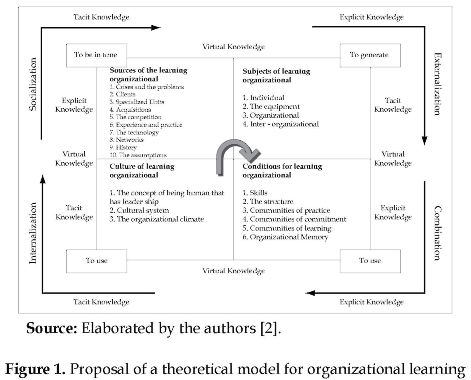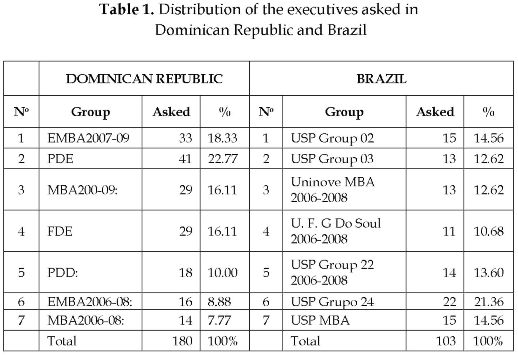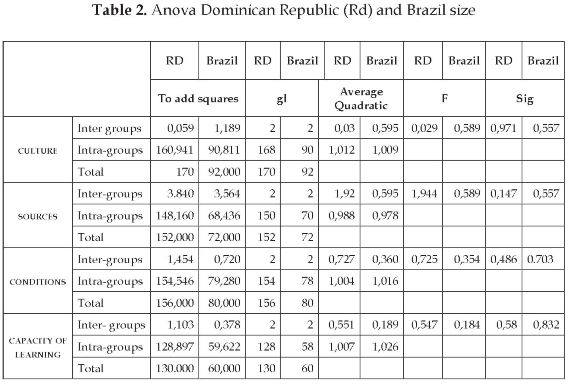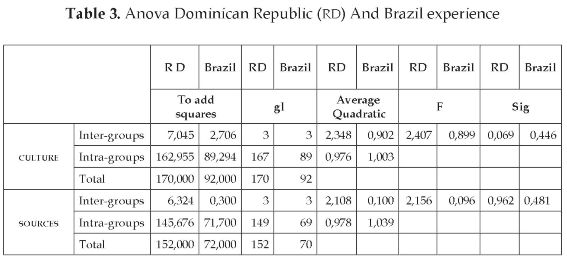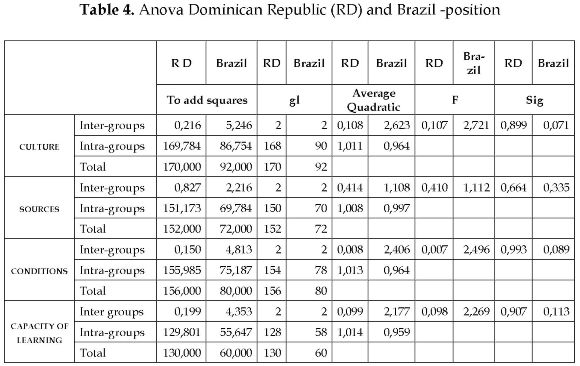Services on Demand
Journal
Article
Indicators
-
 Cited by SciELO
Cited by SciELO -
 Access statistics
Access statistics
Related links
-
 Cited by Google
Cited by Google -
 Similars in
SciELO
Similars in
SciELO -
 Similars in Google
Similars in Google
Share
Ingeniería y Desarrollo
Print version ISSN 0122-3461On-line version ISSN 2145-9371
Ing. Desarro. no.26 Barranquilla July/Dec. 2009
ARTÍCULO CIENTÍFICO / RESEARCH ARTICLE
The organizational learning in Dominican Republic and Brazil
El aprendizaje organizacional en República Dominicana y Brasil
Manuel Alfonso Garzón Castrillon*, André Luíz Fischer**
* Ph.D. Professor of the School of Business, Universidad del Norte. Barranquilla (Colombia). castrillonm@uninorte.edu.co.
Correspondencia: Universidad del Norte, km 5 vía a Puerto Colombia, A.A. 1569, Barranquilla (Colombia).
** Ph.D, Professor of the School of Economics, Business and Accounting of the University of São Paulo (Brasil). afischer@usp.br
Fecha de recepción: 10 de marzo de 2009
Fecha de aceptación: 27 de agosto de 2009
Abstract
This paper comprises a research developed in organizational learning in the management of knowledge research area. The design required a theoretical model, and a test of 180 surveys applied to Executives from large, medium and small companies of Dominican Republic and 103 in Brazil. The general objective of the study is to characterize organizational learning and to determine how it influences the results of organizations. Finally observing the levels of significance for each one of the variables it is possible to conclude that all considered hypotheses H1, H2, H3, H4, were valid, finding that the capacity of organizational learning is directly influenced by the sources, the conditions and the culture of organizational learning, having as subjects the people, the equipment, the organizations and Inter-organizational learning.
Keywords: Capacity of learning, Culture, Sources and Conditions for Organizational Learning.
Resumen
Este artículo comprende una investigación desarrollada sobre el aprendizaje de organización en la línea de investigación Gestión del conocimiento. Requirió el diseño un modelo teórico, el instrumento se aplicó a 180 ejecutivos, de grandes medianas y pequeñas empresas de República Dominicana, y 103 de Brasil. El objetivo general del estudio es caracterizar el aprendizaje de organización y determinar cómo influye en los resultados de organizaciones. Se observaron los niveles de la significación para cada de las variables concluyendo que todas las hipótesis supuestas H1, H2, H3, H4 se aceptan; se encontró que la capacidad de la organización para aprender está influenciada directamente por las fuentes, las condiciones y la cultura para el aprendizaje organizacional, teniendo como sujetos los individuos, los equipos, las organizaciones y el aprendizaje inter-organizacional.
Palabras clave: Aprendizaje organizacional, modelos teóricos, capacidad de aprendizaje, fuentes, condiciones, cultura y sujetos del aprendizaje organizacional.
1. INTRODUCTION
Organizational learning is a field of academic research and professional practice with a relatively recent development. The omnipresence of knowledge in the diverse dimensions of organizations becomes an inter-phase and this depends fundamentally on the people.
Therefore the need to achieve an explicit answer for several questions coming from this postulate still persists. Learning in the organization is associated with a superior yield. This leads to the following research questions: Which are the most feasible conditions to make this happen? Which are the most feasible conditions which influence learning processes within organizations?. Which are the most feasible variables that stimulate learning processes within companies ?
Organizational learning leads to the achievement of benefits or other results that reinforce the positioning and maintain competitiveness. The final question: Is organizational learning capability a great possibility to make contributions for the decision making process oriented to the company's sustainability?
Problem
¿Is the learning capability of sources, subjects, culture and conditions for the learning process determinant for organizational results?
General objective
To characterize the capacity of organizational learning and to determine how it influences the Dominican and Brazilian organizations.
Specific objectives
• To establish whether the sources of organizational learning, contributes or not, to the organization learning within companies.
• To establish whether the conditions of organizational learning, contributes or not to, the organization learning within companies.
• To establish whether the culture of organizational learning, contributes or not to, the organization learning within companies.
• To determine whether the capacity of organizational learning, contributes or not to the results of the organization.
2. STATE OF THE ART AND IDENTIFICATION OF THE SPECULATIVE ARGUMENTS
Literature on organizational learning has grown lately, not only in volume, but also in disorganizing the dimensions of the subject. The discipline is located in the confluence of different research fields of interdisciplinary forms as Dogson [1] states: psychology (cognition theory), sociology (culture), the economy (theory of the company/enterprise based on resources and the economy based on knowledge) and finally, administration has an important role on innovation, strategy, productivity, the decision making process and the organizational change. All this extends the complexity and the diversity of this issue.
Research in organizational learning can be divided into two great different and discrepant groups; the first prescriptive, made by consultants and investigators oriented to the organizational transformation, taking as construction bases for theoretical experiences practices of success, whose center of analysis is the attributes organizations must have to learn: It also has a prescriptive and normative literary direction with an absence of questions on the possibilities of how the organizations learn, generating tools for the present organizational action. The other one, is analytical descriptive, constituted by academics who theorize based on empirical research, whose center is the analysis and the comprehensive explanation of the phenomenon, and specifically the process through which organizations are learning under a descriptive direction. It criticizes and analyses, and it tries to find answers concerning the possibilities of how organizations learn.
3. PROPOSAL OF A THEORETICAL MODEL FOR ORGANIZATIONAL LEARNING
In the model of organizational learning of Garzón et al. The dominant variables are "sources of organizational learning, subjects of organizational learning, culture for organizational learning and conditions for organizational learning" [2].
Definition of organizational learning: It is the capacity of the organizations to create, organize and process information from its sources, to generate new individual, equipment, organizational and Inter-organizational knowledge, generating a culture that facilitates and allows the conditions to develop new capacities, to design new products and services, to increase the existing supply and to improve processes, oriented to sustainability [3]-[7].
Knowledge Typologies: The explicit knowledge which is the knowledge I specify, implicit knowledge and virtual knowledge. The conversion of knowledge, [2],[10] is considered as the socialization and transmission of the explicit knowledge between two or more people. The exteriorization is necessary so that the explicit knowledge has an effect in the organization. The combination, to reshape unequal bodies of knowledge I specify and the internalization, the transformation of the recently created knowledge through the socialization, its exteriorization and combination.
3.1. Variable sources of organizational learning
There are different situations that must be considered and be used in companies to generate learning and they are classified as: the crises and the problems, the clients, the specialized units; the acquisitions; the competition; the experience and the medical instructors, technology, networks, history and the assumptions. [9]
It has been stated by Beazley [2] that the knowledge derived from human sources as much inanimate, is critical for productivity, innovation and performance of the employees. Therefore, the access to both forms is important, guaranteeing that the required critical operative knowledge for a performance of superior level is conserved to be transmitted to the employees who come in the future, and it is of explicit knowledge, virtual and explicit.
3.2. Variable conditions for organizational learning
The knowledge must be transmitted and conserved through the different conditions that the organizations offer for its generation. The conditions they facilitate for organizational learning are: competitions to learn and to de-learn; structure, communities of practice; commitment communities; learning communities; organizational memory [2], [3], [5]; [10] - [15]
3.3. Variables subject to organizational learning
These are: individuals, equipment, organizational and inter organizational variables [3], [5], [10], [11], [13], [15], [16].
3.4. The Culture Variable for organizational learning: It is the collective conscience that is expressed in the meaning system shared by the members of the organization who identify it and differentiate it from others. The sub-variables of the organizational culture are: the concept of human being held by the leader of the organization, the cultural system, and the organizational climate [4], [10], [12] - [17], [19].
4. METHODOLOGY
Sources of information
Primary source: Survey Likert Type. The survey was the instrument used for the research. It was developed by means of methodology pictures, to structure an instrument composed of 138 items, with which to measure the creation and impulse of the organizational factor, which depends to a large extent, on its formulation and the knowledge and experience of the investigator
Second Source: Documents, books, thesis, cases made on the research object, analyses of content of selected writings made by the best authors, without distinction of country or language that allowed a critical and reflective understanding of the phenomenon. An integral reading was made based on the content analysis. Software Atlas allowed the processing of the qualitative data, characterizing the contributions based on units of analyses whose descriptive contribution allowed an explanation of the problem.
Hypothesis
• H1: The sources of organizational learning, allow its development in the organizations.
• H2: The conditions for organizational learning, allow its development in organizations.
• H3: Organizational culture allows organizational learning to be more feasible.
• H4: The capacity of organizational learning is determined by the sources, the conditions and the organizational culture.
5. RESULTS
Results of the pilot proof of the Likert type instrument
The test was applied to 35 executives who participated in programs for directors' formation in Dominican Republic. From the pilot survey, the pertinence of items was evaluated. It included the test, which aimed at determining the factors and therefore, a key mechanism in the evaluation of the objectives. With the method of main components, and the supported coefficient of correlation1 in package SPSS 15,0 redundant items were suppressed. This method helps compressing the most significant variable that facilitates an index with the correlation of coefficient2 and the root characteristic of the variance of each item.
We made the analysis of results considering the dimensions of each one of the areas of evaluation related to organizational learning. Later, based on the correlation matrix, the analysis of main components was disturbed looking for a new indicator to be generated. With the intention of assuring the contribution of the average of the dimension with respect to the total, the correlation between these averages was established. This correlation showed the pertinence of the dimension as analysis variable in the context of organizational learning, obtaining the following results:
Culture variable for organizational learning: 26 statements were designed and we eliminated the redundant questions. Ten (10) statements were left.
Subject variable of organizational learning 22 statements were designed and redundant questions were eliminated.
Conditions for organizational learning: 25 statements were designed and we eliminated redundant questions. Thirteen (13) statements were left.
Sources for organizational learning: Fifty six (56) statements were designed and we manipulated them to eliminate redundant questions; seventeen (17) were left.
Redesign of the Instrument
Based on the previous results, we elaborated new methodology pictures along with the new version of the instrument proposed for the research, with three variables grouping forty items. We eliminated the variables not represented in any of the three items concerning subjects of the organizational learning and, therefore, are not included in the final instrument used in this research.
With the factor matrix and the questions, the affinity of variables with each factor was identified and we suppressed them from the measuring instrument. For this reason variables having correlations with any of the three components greater than 0, 6, 40 variables were selected. With this empirical identification, we observed that the 3 factors are culture for organizational learning, sources for organizational learning and conditions for organizational learning.
Results of the research in Dominican Republic and Brazil
The analysis of variance between the dimensions shows homogeneity in the tendency of the answer. The population distribution of the executive's surveys in Dominican Republic appears in tables 1, 2, and 3.
In agreement with ANOVA analysis for the Sources of organizational learning, Conditions for organizational learning and Culture for organizational learning, we can say that the samples were taken from populations with the same significance levels of 0,557; 0,557; 0,703 and 0,832, in relation with the size of the company where the executives who responded the survey in Brazil work; 0,971, 0,147; 0,486; 0, 58 in Dominican Republic.
In agreement with ANOVA analysis for the variable Sources for organizational learning, Conditions for organizational learning and Culture for organizational learning, we can affirm that the samples were taken from populations with the same significance levels of: 0,446; 0,481; 0,481 and 0,952, in relation with the experience of the company where the executives who responded the survey in Brazil work, and 0,069; 0,962; 0,822 and 0,822 in Dominican Republic.
In agreement with ANOVA analysis for the variable Sources of organizational learning, Conditions for organizational learning and Culture for organizational learning, we can say that the samples were taken from populations with the same significance levels: 0,071; 0,335; 0,089 and 0,113, in relation with the position of the company where the executives who responded the survey in Brazil work and 0,899; 0,664; 0,993; and 0,907 in Dominican Republic.
It is possible to say that the hypotheses H1, H2, H3 and H4 are valid at the given significance levels. The analysis was done grouping the hierarchic level, the labor experience and the size of the company, with a significance level 2, 10; 2, 29; 2, 52 and 1.67, in Dominican Republic and with a significance level of 0,557; 0,557; 0.703 and 0.832 in Brazil, for the variable Sources,
Conditions, Culture and Capacity of Organizational Learning, observing these significance levels for each one of the variables we can conclude that all the given hypotheses are valid.
CONCLUSIONS
The proposed model, looks for balancing each one of the tendencies identified in the state-of-the-art and the speculative arguments alluded in this work, conforming theoretical corpus that establishes that if companies want to impel organizational learning, they must "drink" from seven identified sources, facilitating the five proposed conditions, designing a structure oriented to learning by means of the development of competitions to learn and to "de learn", stimulating the creation and operation of community practices, learning and commitment, documenting and stimulating the use of the organizational memory, for which, it is necessary to generate a culture that allows sharing knowledge based on processes of human management, impelling values and principles that are preached and applied, obtaining a propitious climate for learning.
One first approach to organizational learning, confirms that current companies need the organization of new management tools allowing approaching new realities people face day by day in organizations in order to create value.
Being knowledge the capacity to create closer links with clients, the capacity to analyze corporative information and attribute them new uses, the capacity to create processes that qualify the workers from anywhere to access and to use information to conquer new markets and, finally, the capacity to develop and to distribute products and services for these new markets in a faster and more efficient way.
One of them are the ten (10) sources of organizational learning, from which the companies in Dominican Republic and Brazil "drink" and these are: the crises and the problems; the clients; the specialized units; the competition; the experience and the medical instructors; technology and history.
We also identified that of three sub-variables proposed in the organizational culture variable, those which facilitate organizational learning are: the cultural system and the organizational climate.
In relation with conditions for organizational learning variable, the responses confirmed that the six sub-variables facilitating the learning are: competitions to learn and to de-learn; the structure; the practice communities; the learning communities; the communities of commitments and the organizational memory.
We conclude that for the companies where the executives who responded in Dominican Republic and Brazil work, the capacity of organizational learning is directly influenced by the sources, the conditions and the culture for organizational learning, having as subjects the people, the equipment, the organizations and the Inter-organizational learning. We has left the analysis of the surveys applied in Dominican Republic and Brazil, to elaborate the corresponding statistical analyses that are in process.
1 The correlation coefficient measures the association between pairs of variables in this case. The correlation tends to 1 it means that practically the two variables measure the same and that he is redundant therefore is possible to be come off one of them (the one who are more difficult to obtain data). In the measurement that two variables have low correlation is because they contribute more to the explanation of the concept. Statistical Package of Social Science.
2 It serves to determine which items contribute more to explain the concept.
References
[1] M. Dogson, "Organization Learning Review of some literatures", Organization Studies, vol. 4, no 3, pp. 375-394, January 1993. [ Links ]
[2] M.A. Garzón, Marco teórico del aprendizaje organizacional, avance de tesis posdoctoral, Universidad de Sao Paulo (Brasil), 2007. [ Links ]
[3] V. Krogh, Facilitando a criação do conhecimento, reinventando a empresa como o poder dar inovação continua, Rio de Janeiro, Campus, 2001. [ Links ]
[4] J. Etkin, Gestión de la complejidad en las organizaciones. México D.F.: Oxford University Press, 2003. [ Links ]
[5] I. Nonaka and H. Takeuchi, La organización creadora de conocimiento. Cómo las compañías japonesas crean la dinámica de la innovación. México: Oxford University Press, 1999. [ Links ]
[6] N. Dixon, "Function at the edge of knowledge A study of learning process Review Management Learning, 2001. [ Links ]
[7]G.J. Cutcher, Knowledge management resource center KM, San Diego (California): Oxford University Press, 2000. [ Links ]
[8] W. Choo Chu, La organización inteligente. México D.F.: Oxford Press, 1998. [ Links ]
[9] H. Beazly, "Knowledge continuity: the new Management function", Journal of organization excellence, vol. 22, No 3, 65-81, 2003. [ Links ]
[10] P. Senge, Escuelas que aprenden. Bogotá, D.C.: Norma, 2002. [ Links ]
[11] M. Peluffo, et al., Introducción a la gestión del conocimiento y su aplicación al sector público, Santiago de Chile, ILPES, 2002. [ Links ]
[12] A. Quintero, et al., "La empresa que educa", trabajo de grado de Maestría en Educación, Universidad de la Sabana, Bogotá D.C., 2003. [ Links ]
[13] B. Muñoz-Seca, et al., Del buen hacer y el buen pensar. Madrid: McGraw Hill, 2003. [ Links ]
[14] J. Meister, Universidades empresariales. Bogotá D.C.: McGraw Hill, 1999. [ Links ]
[15] P. Drucker, La gerencia en la sociedad futura. Bogotá D.C.: Norma, 2002. [ Links ]
[16] T. Davenport, et al., Conocimiento en acción. Brasil: Prentice Hall, 2001. [ Links ]
[17] C. Méndez, Marco teórico para la cultura organizacional, Universidad & Empresa, vol. 1, No 7, pp. 45-65, 2004. [ Links ]
[18] P. Senge, "El aprendizaje organizacional en el siglo XXI", conferencia impartida en Buenos Aires, July 25, MIT (traducción libre), 2003. [ Links ]
[19] C. López, "Aprendizaje organizacional", en: http://www.gestiopolis.com/canales/gerencial/articulos/no%203/aporg.htm [Acceded June 2008]. [ Links ]













